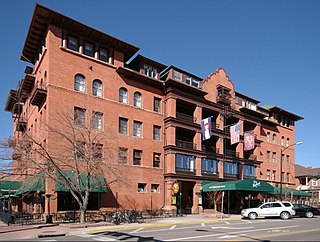
The Central City Opera House is located in the Central City/Black Hawk Historic District in Central City, Colorado, United States. It was constructed in 1878. It has offered operatic and theatrical productions that drew prominent actors and performers in the late 19th-century, and in the early 20th-century it was a motion picture theater.

Carpenter Gothic, also sometimes called Carpenter's Gothic or Rural Gothic, is a North American architectural style-designation for an application of Gothic Revival architectural detailing and picturesque massing applied to wooden structures built by house-carpenters. The abundance of North American timber and the carpenter-built vernacular architectures based upon it made a picturesque improvisation upon Gothic a natural evolution. Carpenter Gothic improvises upon features that were carved in stone in authentic Gothic architecture, whether original or in more scholarly revival styles; however, in the absence of the restraining influence of genuine Gothic structures, the style was freed to improvise and emphasize charm and quaintness rather than fidelity to received models. The genre received its impetus from the publication by Alexander Jackson Davis of Rural Residences and from detailed plans and elevations in publications by Andrew Jackson Downing.

There are more than 1,500 properties and historic districts in the U.S. State of Colorado listed on the National Register of Historic Places. They are distributed over 63 of Colorado's 64 counties; only the City and County of Broomfield currently has none.

Baker is a neighborhood in Denver, Colorado, United States.

The Paramount Theatre is a concert venue in Denver, Colorado, located on Glenarm Place, near Denver's famous 16th Street Mall. The venue has a seating capacity of 1,870 but is a popular destination for large acts looking for a smaller concert setting. With spelling as Paramount Theater, the building was listed on the National Register of Historic Places in 1980.

Jules Jacques Benois Benedict was one of the most prominent architects in Colorado history, whose works include a number of well-known landmarks and buildings listed on the National Register of Historic Places.

Crater Lake Superintendent's Residence, is "an impressive structure of massive boulders and heavy-handed woodwork" at Crater Lake National Park in southern Oregon. It was declared a National Historic Landmark in 1987 as an important example of 1930s National Park Service Rustic architecture.

The Reuel E. Smith House located at 28 West Lake Street in Skaneateles, New York is a picturesque house designed by Alexander Jackson Davis, and later modified by Archimedes Russell. It was built during 1848–1852 and is a "good example of the Gothic Revival mode, which was a reaction against the stringencies of the Greek Revival style" as exemplified by the nearby Richard DeZeng House. It is the only house designed by Davis in Onondaga County that has survived since the demolition of the Charles Sedgewick Cottage on James Street in Syracuse.

The Hotel Boulderado is located at 13th and Spruce St. in downtown Boulder, Colorado. It opened its doors on New Year's Day 1909 and is considered Boulder's first luxury hotel. The original 1908 Otis Elevator is still in operation.

The Mountain States Telephone Building is a historic building located at 931 14th Street in Denver, Colorado, United States. It was listed on the National Register of Historic Places on January 26, 2005.
Edward Divine White Jr., FAIA, was an architect based in Denver, Colorado, whose forty-year practice focused on contemporary architecture and historic preservation. Along with his architectural practice, White was lifelong friend to Jack Kerouac from 1947 to Kerouac's death in 1969. The pair exchanged over 90 letters and postcards during that time.

The John Littig House is a historic building located on the northwest side of Davenport, Iowa, United States. The Gothic Revival style residence was built in 1867 and has been listed on the National Register of Historic Places since 1984 and on the Davenport Register of Historic Properties since 1993.

William Ellsworth Fisher was an architect who founded the Denver, Colorado firm that became Fisher & Fisher.

The Crawford House is a building in Steamboat Springs, Colorado, USA, that is listed on the National Register of Historic Places for its importance as the primary residence for 36 years of James Harvey Crawford, the Father of Steamboat Springs, and his wife, Margaret Emerine (Bourn) Crawford, the Mother of Routt County. The two of them together were among the most influential pioneering families in northwest Colorado. The Crawford House is also listed as a rare local example of residential Romanesque Revival architecture.

John James Huddart (1856–1930), known usually as John J. Huddart, was a British born and trained architect who practised out of Denver, Colorado in the United States. At the end of the Nineteenth century he was one of Denver's leading architects, known for his work on public buildings and as a courthouse architect. His practice lasted from 1882 to 1930 and commissions included Charles Boettcher House in Denver, Colorado's Fort Morgan State Armory, Denver's Filbeck Building, and six of Colorado's county courthouses.
Boulder Crescent Place Historic District is a historic area in Colorado Springs, Colorado along West Boulder and Cascade Avenue near the intersection of the two streets. It is a National Register of Historic Places listing and is on the Colorado State Register of Historic Properties.

The Adolph J. Zang House, also referred to as the Gargoyle House, is a National Register of Historic Places-listed residence in Denver, Colorado. It is located at 1532 Emerson Street. William Lang was the architect. It was constructed in a Gothic architecture/ Romanesque architecture style. It has also been described as Late Victorian eclecticism with elements of Chateauesque, Gothic, and Richardsonian Romanesque architecture. It remains largely intact.
Merrill H. Hoyt was a prominent American architect, business man and leader in the building design community of Denver, Colorado from 1910 to 1933.
Glen Wood Huntington (1856-1943) was an American architect who practiced mainly in Denver, Colorado. A number of his works are listed on the National Register of Historic Places or designated as Denver Landmarks for their architecture.

















